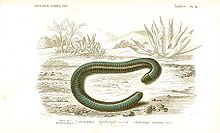| Caeciliidae | |
|---|---|
 | |
| Siphonops annulatus | |
| Scientific classification | |
| Kingdom: | Animalia |
| Phylum: | Chordata |
| Class: | Amphibia |
| Order: | Gymnophiona |
| Clade: | Apoda |
| Family: | Caeciliidae Rafinesque-Schmaltz, 1814 |
| Genera | |
| Caecilia | |
Caeciliidae is the family of common caecilians. They are found in Central and South America. Like other caecilians, they superficially resemble worms or snakes.
Although they are the most diverse of the caecilian families, the caeciliids do have a number of features in common that distinguish them from other caecilians. In particular, their skulls have relatively few bones, with those that are present being fused to form a solid ram to aid in burrowing through the soil. The mouth is recessed beneath the snout, and there is no tail.[1]
Many caeciliids lay their eggs in moist soil. The eggs then hatch into aquatic larvae, which live in seepages in the soil, or in small streams. However, some species lack a larval stage, with the eggs hatching into juveniles with the same form as the adults, or else lack eggs and give birth to live young.[1]
Phylogeny
Traditional taxonomy, which is reflected in the "Scientific Classification" box in this article, categorizes extant amphibia into three orders: Anura (frogs and toads), Caudata (newts and salamanders), and Gymnophiona (caecilians). However, there is considerable debate among paleontologists and molecular geneticists concerning the phylogenetic relationship between amphibians, and indeed whether Amphibia is a monophyletic clade or a polyphyletic collection of diverse evolutionary lineages.[2]
The more limited debate (operating on the assumption that Amphibia is a monophyletic clade) is whether Caudata is more closely related to Anura (in a shared clade called Batrachia — the traditional view) or to Gymnophiona (suggested by research in 2005). The broader debate is whether Amphibia is monophyletic or polyphyletic. The latter view considers Caudata and Gymnophiona to be more closely related to amniotes (reptiles, mammals and birds) than to Anura.
Species
- Genus Caecilia – common caecilians
- Caecilia abitaguae
- Caecilia albiventris
- Caecilia antioquiaensis
- Caecilia armata
- Caecilia attenuata
- Caecilia bokermanni
- Caecilia caribea
- Caecilia corpulenta
- Caecilia crassisquama
- Caecilia degenerata
- Caecilia disossea
- Caecilia dunni
- Caecilia flavopunctata
- Caecilia gracilis
- Caecilia guntheri
- Caecilia inca
- Caecilia isthmica
- Caecilia leucocephala
- Caecilia marcusi
- Caecilia mertensi
- Caecilia museugoeldi
- Caecilia nigricans
- Caecilia occidentalis
- Caecilia orientalis
- Caecilia pachynema
- Caecilia perdita
- Caecilia pressula
- Caecilia subdermalis
- Caecilia subnigricans
- Caecilia subterminalis
- Caecilia tentaculata
- Caecilia tenuissima
- Caecilia thompsoni
- Caecilia volcani
- Genus Oscaecilia – South American caecilians
References
- ^ a b Nussbaum, Ronald A. (1998). Cogger, H.G.; Zweifel, R.G. (eds.). Encyclopedia of Reptiles and Amphibians. San Diego: Academic Press. p. 57. ISBN 978-0-12-178560-4.
- ^ Fong, Jonathan J.; Brown, Jeremy M.; Fujita, Matthew K.; Bassau, Bastien. "A Phylogenetic Approach to Vertebrate Phylogeny Supports a Turtle-Archosaur Affinity and a Possible Paraphyletic Lissambhibia".
Further reading
- Nussbaum, Ronald A.; Mark Wilkinson (1989). "On the Classification and Phylogeny of Caecilians". Herpetological Monographs. 3 (3): 1–42. doi:10.2307/1466984. JSTOR 1466984.
- San Mauro, Diego; David J. Gower; Oommen V. Oommen; Mark Wilkinson & Rafael Zardoya (November 2004). "Phylogeny of caecilian amphibians (Gymnophiona) based on complete mitochondrial genomes and nuclear RAG1". Molecular Phylogenetics and Evolution. 33 (2): 413–427. doi:10.1016/j.ympev.2004.05.014. PMID 15336675.
- San Mauro, Diego; Miguel Vences; Marina Alcobendas; Rafael Zardoya & Axel Meyer (May 2005). "Initial diversification of living amphibians predated the breakup of Pangaea" (PDF). American Naturalist. 165 (5): 590–599. doi:10.1086/429523. PMID 15795855.
- San Mauro, Diego; David J. Gower; Tim Massingham; Mark Wilkinson; Rafael Zardoya & James A. Cotton (August 2009). "Experimental design in caecilian systematics: phylogenetic information of mitochondrial genomes and nuclear rag1". Systematic Biology. 58 (4): 425–438. CiteSeerX 10.1.1.577.2856. doi:10.1093/sysbio/syp043. PMID 20525595.
- Frost, Darrel R. 2004. Amphibian Species of the World: an Online Reference. Version 3.0 (22 August 2004) American Museum of Natural History, New York, USA
- AmphibiaWeb: Information on amphibian biology and conservation. 2004. Berkeley, California: AmphibiaWeb. Retrieved 26 August 2004